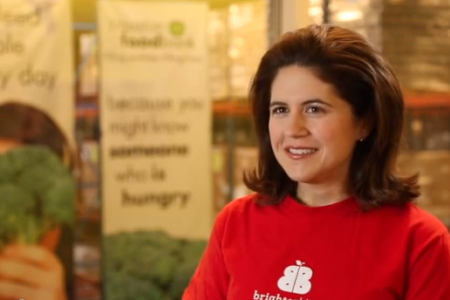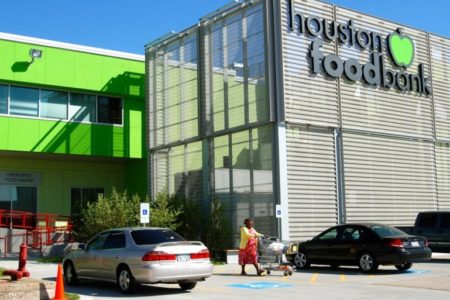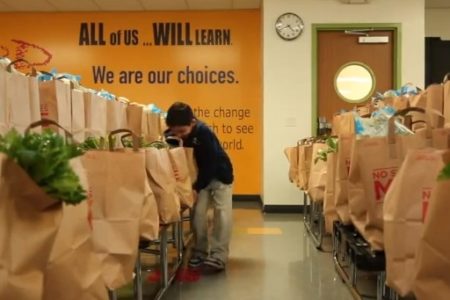Share On Social!
Hispanics make up almost half of the total population in Houston and many live in areas that lack easy access to grocery stores and fresh produce. To grow lasting healthy changes in these communities, teamwork is essential. One mom, determined to bring fresh fruits and vegetables to folks in inner-city Houston, teamed up with a food pantry that had been looking for a creative way to distribute fresh fruits and vegetables to families in need. This is the story of a unique partnership that led to students being sent home from school with a bag fresh produce each week to take to their homes in underserved Houston neighborhoods—and ended in kids demanding extra kale smoothies.
EMERGENCE
Awareness/Learn: When Lisa Helfman and her husband, Jonathon, wanted their family to eat healthier, locally grown foods, they joined a food co-op and brought home a box of fresh, farm-grown produce every week. Gradually, they began to see changes in their young boys’ eating habits.
“Slowly but surely, the boys were choosing fruits and vegetables over typical junk food,” Lisa said.

Source: Salud America!
They wondered: Was it through simply having better access to fresh fruits and vegetables that the boys had begun actually preferring apples and kale over cupcakes and candy?
Lisa and her husband asked themselves this question as they sat among fellow football fans, many of whom were overweight or obese, at a Houston Texans game. They thought about how bringing in healthier option to their home led to their children making healthier choices.
“We thought, ‘how can we bring this kind of change to the inner city?’” Lisa Helfman said. “And how can we add an educational component?”
An idea that began like a football being tossed around the gridiron would eventually lead to a community-wide effort that required many different partners. Little did Helfman know that one future partner was looking for someone just like her who had big ideas to get kids hooked on produce: the Houston Food Bank.
Frame Issue: Food banks and pantries aren’t typically known for their fresh fruits and vegetables.
“When I started, we were almost exclusively shelf-stable items, canned items, boxes of cereal, lots of snacks,” recalls Brian Greene, executive director of the Houston Food Bank.
Many low-income Houston families turn to the Houston Food Bank when they need a little help putting food on the table. As the nation’s largest food bank and a source of food for hunger relief charities in 18 Southeast Texas counties, the Houston Food Bank has no shortage of resources to distribute.

Source: Salud America!
However, Greene saw the food bank moving in a new direction.
“We need to be in the nutrition business, not just hunger business,” he said. “Hunger and obesity are not a contradiction.”
The Houston Food Bank had begun looking into distributing produce.
According to Greene, three billion pounds of produce a year are harvested but not sold. Food pantries across the country could do a lot with three billion pounds of produce. Greene wanted to use the food bank’s resources for the greatest impact possible, but they needed solid programming to make it happen. Knowing all this, a mutual contact introduced Lisa Helfman to Brian Greene, and conversations began.
DEVELOPMENT
Education/Debate: At first, Helfman wanted to go into classrooms and work with kids directly. She envisioned field trips to farmers markets to learn about where fruits and vegetables are actually grown.
Greene wanted something more cost-effective, scalable, and easily replicable.
They decided the core activity of their partnership would be to distribute fresh fruits and vegetables from the food bank. Distributing food at school, where there is a large, consistent gathering of children, seemed like a natural fit.
As chance would have it, Helfman knew Mike Feinberg, the co-founder of KIPP (Knowledge Is Power Program) charter schools in Houston. She reached out to Feinberg with the idea: sending free fresh fruits and vegetables home with students for families, and pairing it with nutrition education—what would later become known as the Brighter Bites program.
Feinberg liked the idea, and the ball kept rolling.
Mobilization: One of the KIPP charter schools, a kindergarten through 3rd-grade campus called KIPP Explore Academy, was willing to try the Brighter Bites idea of sending the healthy food items home to families. KIPP Explore’s student population is 97% Hispanic and 91% on the free or reduced school lunch program.

Source: Salud America!
But the program still needed a nutrition educational piece, so the UT School of Public Health-Houston got involved.
“Our team helped give structure to the idea by identifying that [distributing] 50 servings of produce per week was sufficient. We also developed the nutrition education components as well as the evaluation of the program to see if it is feasible, acceptable and changes the family’s eating habits,” said Dr. Shreela Sharma, an assistant professor at The UT School of Public Health-Houston.
ENACTMENT
Activation: In fall 2012, KIPP Explore Academy put into practice a trial Brighter Bites program to send 2nd and 3rd graders home with a bag of various fruits and vegetables every week.
Frame Policy/Change: About 80% of the produce distributed through Brighter Bites is donated by the food bank. The other 20% is purchased through help by Blue Cross Blue Shield of Texas.
But before parents can qualify to get the food, they have to go through a brief nutrition education program, such as training and tips on how to prepare meals with the produce while keeping health in mind, conducted by officials from The UT School of Public Health-Houston. Students also get their own in-class food education through the Coordinated Approach to Child Health (CATCH) program, also provided by the UT School of Public Health-Houston. Even further, the Brighter Bites volunteers, students at the UT School of Public Health, held taste tests after school for kids and their parents to try some of the yummy produce offerings prepared in healthy ways, such as strawberry and kale smoothies.

Source: Salud America!
More than 700 families were served over the 16-week trial period that introduced kids and their families to pears, butternut squash, jicama, and more.
“Vegetables and fruits are expensive,” said Jackie Calderon, a mother of a 3rd grader at KIPP Explore Academy. “Sometimes I go grocery shopping on Sunday and, come Wednesday, they’ve already gone bad, so sometimes I have to juggle if I can actually buy fresh fruits.”
Brighter Bites provides moms like Calderon with free, frequent produce, cutting the trek to the store out of the picture. Her son Matthew is now asking for tomatoes as an after school snack.
“As a mom, yes, it feels great,” Calderon said.
IMPLEMENTATION
Implementation: As for the Houston Food Bank, Greene said programs like Brighter Bites are just what they need to continue to use produce effectively and inject healthier food into local neighborhoods that otherwise would have trouble accessing it.
“We are shifting our distribution so that it fosters long-term changes that foster life,” Greene said.
The food bank’s board of directors has approved this health-minded direction, meaning that distributing produce, either picked by volunteers or donated by farmers, will be woven into what the Houston Food Bank is all about.
Equity/Sustainability: With continued donations from the food bank, Brighter Bites is expected to expand to The Brighter Bites program is expected to expand into nine schools in areas with limited fresh food access around Houston, bringing healthy options right into the hands of Latino children and their families.
What’s more, state-level lawmakers are taking notice of Brighter Bite’s creative and replicable strategy; a state-wide program may be in Texas’s future, Helfman said.
Addressing hunger and obesity at the same time; that’s a sustainable path, Greene said.
Helfman agrees. She continues to champion the program and was helping out at the school during the pilot programs.
“Obviously if people are hungry, you need to get food out to them,” Helfman said. “But why can’t we feed people that don’t have access to the right food?”
This success story was produced by Salud America! with support from the Robert Wood Johnson Foundation.
The stories are intended for educational and informative purposes. References to specific policymakers, individuals, schools, policies, or companies have been included solely to advance these purposes and do not constitute an endorsement, sponsorship, or recommendation. Stories are based on and told by real community members and are the opinions and views of the individuals whose stories are told. Organization and activities described were not supported by Salud America! or the Robert Wood Johnson Foundation and do not necessarily represent the views of Salud America! or the Robert Wood Johnson Foundation.
ABOUT THE PROGRAM
Salud America! The RWJF Research Network to Prevent Obesity Among Latino Children is a national program of the Robert Wood Johnson Foundation. The program aims to educate researchers, decision-makers, community leaders, and the public in contributing toward healthier Latino communities and seeking environmental and policy solutions to the epidemic of Latino childhood obesity. The network is directed by the Institute for Health Promotion Research at the University of Texas Health Science Center at San Antonio.
For more information, visit http://www.salud-america.org.
By The Numbers
1
Supermarket
for every Latino neighborhood, compared to 3 for every non-Latino neighborhood
This success story was produced by Salud America! with support from the Robert Wood Johnson Foundation.
The stories are intended for educational and informative purposes. References to specific policymakers, individuals, schools, policies, or companies have been included solely to advance these purposes and do not constitute an endorsement, sponsorship, or recommendation. Stories are based on and told by real community members and are the opinions and views of the individuals whose stories are told. Organization and activities described were not supported by Salud America! or the Robert Wood Johnson Foundation and do not necessarily represent the views of Salud America! or the Robert Wood Johnson Foundation.



